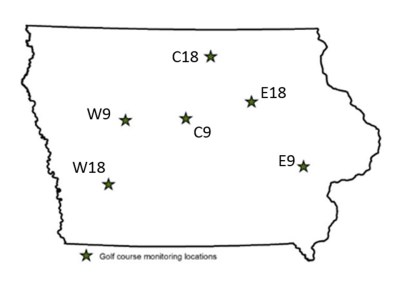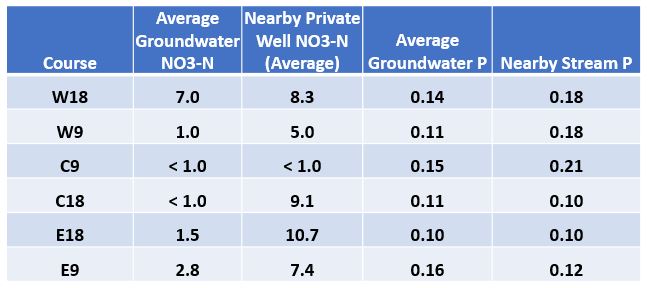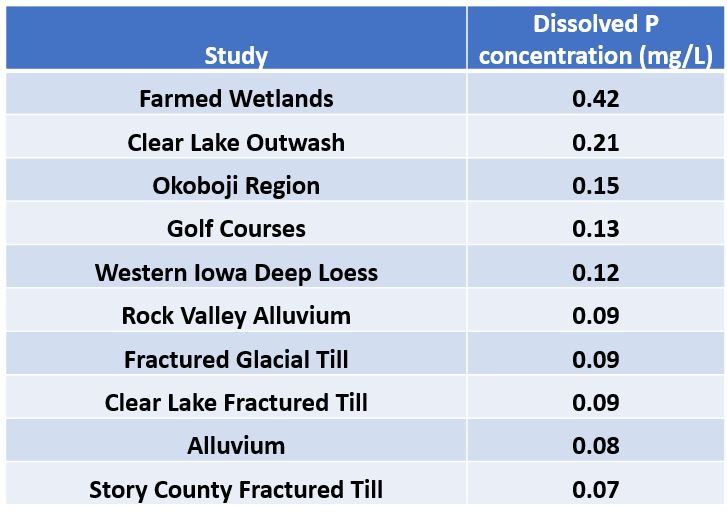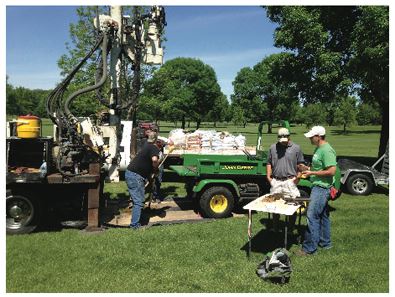You likely know some things about Gulf of Mexico hypoxia. This is the low-oxygen condition that develops off the coast of Louisiana that is driven by nitrogen (N) and phosphorus (P) entering the Gulf in the Mississippi and Atchafalaya Rivers.
Do golf courses contribute to this, and do they degrade local water quality?
Iowa DNR has this information (1): “Nutrients, especially nitrogen and phosphorus, are our main nonpoint pollutants in Iowa. Nutrients can come from fertilizers (both on agricultural land and on residential lawns, golf courses, etc.).”
Former Iowa Governor and USDA secretary Tom Vilsak had this to say (2), with regard to nutrient pollution: “Farmers’ voluntary conservation efforts are a unique story in America. Other people aren’t doing these things. The golf course guys aren’t doing it. The lawn care folks aren’t doing it.”
Former Iowa Secretary of Agriculture Bill Northey (3): “While I support a clean responsible environment, we must also maintain Iowa’s productivity and thriving ag industry. Runoff from urban lawns and golf courses should be included.”
Bill Northey again (4): “I don’t like going into the city and seeing large amounts of nutrients being applied to lawns and golf courses.”
And it’s not just Iowa. Minnesota State Senator Mike Goggin said in an interview (5) that the Minnesota state government was singling out agricultural fertilizer use while not applying the same scrutiny to urban sources of pollution. “Where does it end? Do we go after the golf courses? Do we go after the lawn-care companies?”

I could give you an exhaustive list of similar comments ala “we all want clean water”, but I think you get the point.
So, golf courses are an important component to Iowa’s stream nutrient problem. Myth or reality?
Well, some actual science on this topic exists. Native Iowan and current Johnson County hacker, State Geologist Keith Schilling, is perhaps the number one expert on the subject. When he’s not trying to break 100, Keith does some excellent research in hydrogeology and water quality and while his name appears on no golf trophies, it does appear on more than 160 published scientific papers. As part of his research, he recently led a study of nutrient (nitrogen-N and phosphorus-P) loss from Iowa courses.
There are over 400 courses in Iowa and at least one in each county, and compared to many other states, there are plenty of places to golf in our state. As part of his study, he randomly selected six courses (3-18 hole and 3-9 hole) spaced across Iowa. The studied courses are representative of Iowa’s landforms and ecoregions. Monitoring wells were installed in a tee, fairway, and rough location at each course and soil samples were collected. Quarterly groundwater samples were collected and monitored from the wells for two years, and surface water samples were collected from ponds and streams where they existed.
Groundwater nitrate concentrations averaged from undetectable to 2.8 mg/L (ppm) at five of the courses and 7 mg/L at the western Iowa 18-hole course (W18 in the map). At the West 18 course, the tee and rough wells contained low levels of nitrate (average about 3 mg/L), but the fairway well averaged about 15 mg/L. Some evidence emerged late in the study that this well may have been installed at or near a barn location when the course land was used as a farm, thus there likely was some legacy nitrate associated with the accumulation of livestock manure. As a reference, nitrate was measured in nearby private drinking water wells and these are shown in Table 1, and you can see that groundwater under the golf courses was lower than private well water at all locations.

Groundwater loading rates (average concentration multiplied by the groundwater recharge rate) were found to be about 2.5-3 pounds of N per acre, close to what the pre-settlement condition would have been and only about 1/10th of the nitrate loading occurring within the respective watersheds. Conditions at the Central 18 course were unique in that golf course groundwater could be compared with tile water draining an adjacent row crop field. In this case, tile water had nitrate concentrations of 13.1 mg/L, whereas golf course groundwater had nitrate values < 1 mg/L. Considering both sites have the same soils and were monitored during the same climate regime, differences in subsurface water concentration can only be due to differences in land use and fertilizer management.
Groundwater phosphorus (dissolved) at the golf course wells averaged 0.10 to 0.16 mg/L. These levels were similar to the rivers draining the respective golf courses (0.10 to 0.21 mg/L). Data for dissolved phosphorus were not available for the nearby drinking water wells. Table 2 shows the average groundwater dissolved phosphorus at the golf course locations versus those measured at other groundwater studies around Iowa.

Interestingly, turf grass has similar nutrient requirements to that of corn. But there is very little evidence that much nitrogen is lost from turf, and in fact scientists have investigated the potential of turf grasses to scavenge nitrogen when used as a cover crop and as a living mulch to grow between corn rows. One problem with the latter scenario: turf grasses can out-compete corn for the nutrients.
Now, don’t think I am giving you license to fertilize your lawn with any amount of N and P that you please. There is evidence that the phosphorus in turf fertilizer can degrade local water quality, especially when applied to properties adjacent to natural lakes. As such, Minnesota and Wisconsin restrict phosphorus application to residential lawns. While such regulations don’t exist in Iowa, phosphorus should only be applied when a soil test has indicated a need for additional amounts. The Iowa Professional Lawn Care Association has placed a self-enforced restriction on the use of P fertilizers on lawns surrounding lakes and other waterways.
In researching this piece, I found that Iowa is a golfing state (I, however, have never golfed a round in my life even though I’ve seen the 19th hole a few times). In terms of golf courses per square mile, Iowa is 19th, even ahead of Minnesota where golf is hugely popular. Still, the total golf course area in Iowa relative to row crop area is very small. In the nitrate-famous Raccoon River watershed, golf courses occupy 0.14% of the area (i.e. 14 out of every 1,000 acres) but contribute (according to Keith’s research) only 0.1 out of every 1,000 pounds of the nitrate load. If the entire Raccoon River watershed were a golf course, the stream’s nitrogen load would decrease by more than 90%.
Keith’s research on this subject can be found in scientific journals, but the easiest access is on-line here.

- https://www.iowadnr.gov/Environmental-Protection/Water-Quality/Watershed-Improvement/Watershed-Basics.
- https://www.iowafarmbureau.com/Article/Vilsack-touts-voluntary-conservation-efforts
- Iowa Nutrient Reduction Strategy, public comment #1089.
- Iowa Nutrient Reduction Strategy, public comment #109.
- http://www.winonapost.com/Community-Record/Business-News/ArticleID/58989/Fertilizer-rule-debate-intensifies-
- https://www.gcsaa.org/gcm/2017/june/how-much-do-golf-courses-contribute-to-gulf-of-mexico-hypoxia.